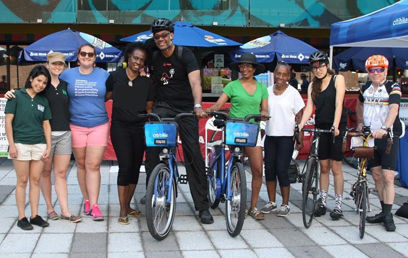They went from not feeling it to seriously wheeling it.
Citi Bikes got a dubious reception when they arrived in Bedford-Stuyvesant in 2013; now, many locals are singing the bike-sharing program’s praises.
Residents initially opposed the bikes and their space-hogging curbside docks because they saw them as evidence of encroaching gentrification, said a representative of the Bedford-Stuyvesant Restoration Corporation, which launched a pro-Citi Bike campaign about a year after rows of the blue two-wheelers started showing up on area streets.
“The effort was challenging in neighborhoods going through gentrification, and I think oftentimes when people see change in their community, they see that change as another signal of that,” said Tracey Capers, a vice president of the corporation, which surveyed Bedford-Stuyvesant locals and concluded that bike use in the area should be encouraged.
“We were looking at the health of the neighborhood, jobs, and environmental development, and when Citi Bike came to the neighborhood we took that on as an effort to see how we can change the conversation,” said Capers. “We mounted a multi-faceted plan and strategy of acceptance of Citi Bike into the community.”
Residents surveyed by Restoration representatives said they were concerned about the safety and affordability of Citi Bikes, how to operate them, and whether they were primarily intended to be used by newcomers to the area. Capers said the corporation responded by holding Citi Bike-themed community events, and distributing brochures and posters around the neighborhood showing blacks and Latinos riding the bikes.
“We showed them that it can be used as a tool and it can be used by them,” said Capers. “To create a culture of biking we held family-centered events with children so they can learn to ride, and showed them that it was exercise, it’s affordable, and it can save you time.”
The Restoration Corporation has tracked the growth of the Citi Bike program since its arrival in Bedford-Stuyvesant, and reports that ridership spiked in the year between May 2015 and May 2016, rising 56 percent during that period as compared to a 46 percent jump citywide. The tally among residents of New York City Housing Authority developments in the neighborhood was even more dramatic, with Citi Bike trips skyrocketing 225 percent from May 2015 to May 2016.
Those results have convinced Capers and her Restoration Corporation colleagues that predominantly minority communities across the city should embrace Citi Bike.
“We want to get these [in] more [minority] communities because the bikes are more environmentally friendly, and they allow residents to commute efficiently and more comfortably in their neighborhoods,” she said.
























